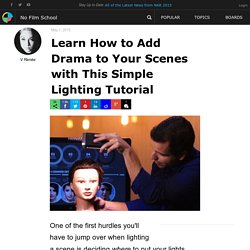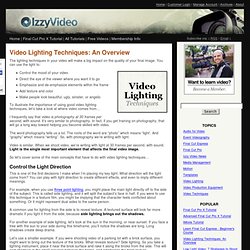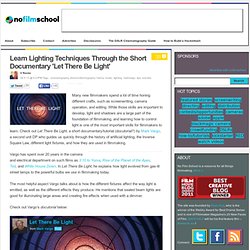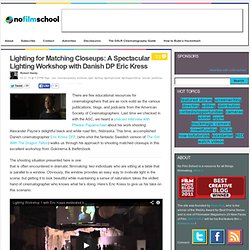

Learn How to Add Drama to Your Scenes with This Simple Lighting Tutorial. One of the first hurdles you'll have to jump over when lighting a scene is deciding where to put your lights.

For beginners, this can be a daunting task if you don't know the basics of lighting. A good place to start, though, is with the key light, and this video from SLR Lounge offers a great lesson on five common key light patterns that will teach you how to set them up, how to spot each of their aesthetic characteristics, and what emotional affect it'll have on your audience. Even though this is technically a still photography tutorial, the principles still translate to video and film.
(You can spot each pattern in movies and TV all the time.) With one single light you can see how big of a change you can make to your images, ramping up/down the dramatic feel by arranging it at different angles. You can check out this graphic to see how each lighting pattern is done, as well as how it affects your subjects' perception to your audience. Filmmaking: Using Flags to Control Shadow. Video Lighting Techniques: Overview of the Fundamentals. The lighting techniques in your video will make a big impact on the quality of your final image.

You can use the light to: Control the mood of your videoDirect the eye of the viewer where you want it to goEmphasize and de-emphasize elements within the frameAdd texture and colorMake people look beautiful, ugly, sinister, or angelic To illustrate the importance of using good video lighting techniques, let’s take a look at where video comes from… I frequently say that video is photography at 30 frames per second, with sound. It’s very similar to photography. The word photography tells us a lot. Video is similar. So let’s cover some of the main concepts that have to do with video lighting techniques…
Le portrait en studio - la boîte lumineuse. Learn Lighting Techniques Through the Short Documentary 'Let There Be Light' Many new filmmakers spend a lot of time honing different crafts, such as screenwriting, camera operation, and editing.

While those skills are important to develop, light and shadows are a large part of the foundation of filmmaking, and learning how to control light is one of the most important skills for filmmakers to learn. Check out Let There Be Light, a short documentary/tutorial (docutorial?) By Mark Vargo, a second unit DP who guides us quickly through the history of artificial lighting, the Inverse Square Law, different light fixtures, and how they are used in filmmaking. Vargo has spent over 20 years in the camera and electrical department on such films as 3:10 to Yuma, Rise of the Planet of the Apes, Ted, and White House Down. In Let There Be Light, he explains how light evolved from gas-lit street lamps to the powerful bulbs we use in filmmaking today. Check out Vargo’s docutorial below: What do you think? [via Filmmaker IQ] Related Posts. Basic Lighting Lesson: Understanding Hard Light and Soft Light.
Lighting does more than just expose your image.

It’s one of the very basic tools that filmmakers have at their disposal to create an atmosphere for their story. While you need a certain quantity of light to give your movie the proper exposure, it’s actually the quality of the light that creates the look for your film. If you’re looking for a basic lesson in the differences between hard light and soft light, and what they can do for your image, look no further than the tutorial below.
Somehow Zacuto squeezed in some NSFW language in the 3 minute tutorial (thanks to Notes On Video for the link): While some of you may be familiar with the finer points of lighting, I think it’s always helpful to get a little bit of a refresher. Even though you can learn a lot about lighting from watching movies, I’ve found it far more helpful to observe the way light interacts with surfaces in real life. What are some of your favorite uses of hard or soft lights? [via Notes On Video ] Related Posts. Lighting for Matching Closeups: A Spectacular Lighting Workshop with Danish DP Eric Kress. There are few educational resources for cinematographers that are as rock-solid as the various publications, blogs, and podcasts from the American Society of Cinematographers.

Last time we checked in with the ASC, we heard a podcast interview with Phedon Papamichael about his work shooting Alexander Payne’s delightful black and white road film, Nebraska. This time, accomplished Danish cinematographer Eric Kress DFF, (who shot the fantastic Swedish version of The Girl With The Dragon Tattoo) walks us through his approach to shooting matched closeups in this excellent workshop from Gokinema & thefilmbook.
The shooting situation presented here is one that is often encountered in dramatic filmmaking: two individuals who are sitting at a table that is parallel to a window. Obviously, the window provides an easy way to motivate light in the scene, but getting it to look beautiful while maintaining a sense of naturalism takes the skilled hand of cinematographer who knows what he’s doing.